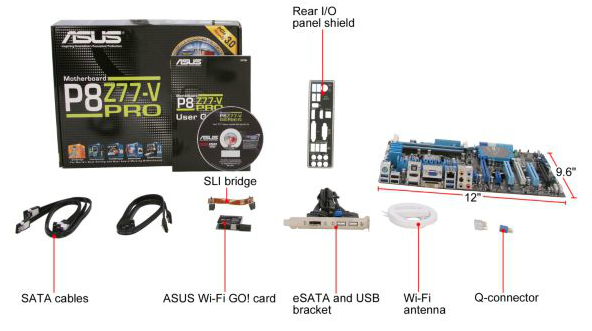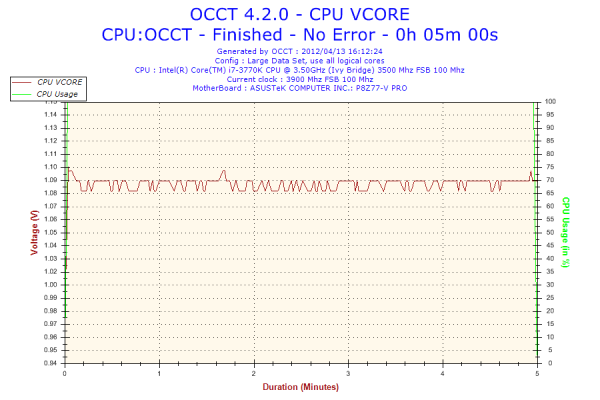Intel Z77 Motherboard Review with Ivy Bridge - ASRock, ASUS, Gigabyte, and MSI
by Ian Cutress on May 7, 2012 7:40 PM EST- Posted in
- Motherboards
- MSI
- Gigabyte
- ASRock
- Asus
- Ivy Bridge
- Z77
ASUS P8Z77-V Pro - In The Box
The ASUS P8Z77-V Pro retails at $225-$235, essentially $100 more than the ASRock Z77 Extreme4, so I would expect a good amount in the box to help sweeten the price point. Thankfully, we get a good amount!
Driver CD
User Manual
IO Panel
4 SATA Cables
SLI Finger
WiFi Go! 802.11 a/b/g/n WiFi card
WiFi magnetic antenna
USB and eSATA back panel
ASUS Q-Connectors

The addition of WiFi on the board obviously adds substantial value – personally, at home, I have my machines connected via WiFi, and ASUS say that at least 25% of their user base is in a similar position, hence the addition to the package.
Voltage Readings
Using OCCT we monitor the voltage change of the motherboard under load. This represents the direct correlation between the Load Line Calibration and how the processor/motherboard deals with voltage requests while under load. This is not to be confused with the quality of power delivery, but more an indication of how aggressive the default LLC settings are on a motherboard.
The ASUS board has regular power delivery, with minimal voltage ripple under load.
Overclocking
Note: Ivy Bridge does not overclock like Sandy Bridge. For a detailed report on the effect of voltage on Ivy Bridge (and thus temperatures and power draw), please read Undervolting and Overclocking on Ivy Bridge.
ASUS overclocking tools have been consistent over the few previous chipsets. In the BIOS, OC Tuner is a simple setting that enables a ‘Fast’ overclock on the system. Similarly, the TPU button on board does a similar action. In the OS, the TurboV Evo part of the software offers ‘Fast’ and ‘Extreme’ auto overclocking modes. For manual overclocking, the TurboV Evo software allows the user to play with an overclock in the OS, which should aid in setting a more permanent overclock in the BIOS.
Auto Overclock: ‘Fast’ mode (either through BIOS or OS) implements an immediate 19% overclock, with 41x on the multiplier and 102 MHz base frequency, ending with 4182 MHz overall. This is coupled with a memory overclock, which in my case it did XMP but backed off one memory strap. What was odd was that the memory was set to a 3T command rate!
‘Extreme’ mode implements a algorithmic testing tool in the OS to probe overclock limits. By slowly upping the multiplier and voltage, the system performs stability tests until the system crashes. The system reboots and then implements BCLK tuning, while still monitoring temperatures. In our test, the initial boot implemented a 20% overclock at 41x103 (4223 MHz), and then performed multiplier testing. At 47x, the system restarted to 46x and started BCLK tuning. At 104.5 MHz, the system restarted again, do a ‘Failed Overclock’ screen on boot. After pressing F1 for Setup, then F10 for Save and Exit, the operating system showed an overall 36% overclock – 46x103.8 (4774 MHz). At load, this gave 1.280 volts at load, giving an immense 94ºC peak temperature during PovRay. I do not think I would be happy with that temperature for a daily system.
Manual Overclock: With the overclock performance of Ivy Bridge processors being highly limited by temperature, having a low voltage is key along with hope that it does not compromise the overclock. In this case, I have started with 1.100 volts on the CPU and adjusting only the CPU multiplier to see what stable overclock we can get, before upping the voltage further. For this, PLL Overvoltage was also enabled.
At 1.100 volts, the highest multiplier that was stable was 45x, giving 4.5 GHz. This gave 68ºC at load with PovRay.
At 1.150 volts, the highest multiplier that was stable was 46x, giving 4.6 GHz. This gave 76ºC at load with PovRay.
At 1.200 volts, the highest multiplier that was stable was 47x, giving 4.7 GHz. This gave 83ºC with PovRay and 86ºC with OCCT. The system did boot at 48x, but gave 94ºC under PovRay as well as memory errors.










117 Comments
View All Comments
hasseb64 - Wednesday, May 9, 2012 - link
My last build was with a Z68 ATX MB, such a build will never happen again in my house. Next update will have Micro-ATX or maybe even a Mini-ATX.During my 15 years of computer building I have never used more than 1 GPU
In next computer I will probably not use any more expansion, today I have a old SB card installed.
And 2 slots for memory will do too (2x8 GB)
All HDDs are in separate WHS2011 box
ATX feels more and more like a thing of the past, these Taiwan makers are holding on as it seems but the future for them are to deliver smaller packages = less money.
ggathagan - Thursday, May 10, 2012 - link
For the vast majority of folks, you are correct, and the board manufacturers are also catering to that market.There are, however, plenty of people that *do* have multi-GPU systems.
Further, there are more uses for PCIe than just GPU's; RAID controllers, 10GbE NIC's, and high end sound cards, to name a few.
Zoomer - Tuesday, May 15, 2012 - link
To be honest, with GPUs these days, 7 slots seem to be not enough. 2 slots are needed for the GPU, 3 for semi-decent cooling, particularly for these darn open air coolers manufacturers like to use for some reason.Sysiphus - Wednesday, May 9, 2012 - link
Is it possible to control 3pin fans on this boards? I didnt see a option and the asus board has only 4pins. Chassisfans are normally 3pinned.kstan12 - Wednesday, May 9, 2012 - link
i own the asus p8z77-v pro. i have plugged my rear chassis & side panel fans into the 4 pin connectors on the mobo and i can control them with fan expert 2.i bought a few of these:
http://www.newegg.com/Product/Product.aspx?Item=N8...
Zoomer - Tuesday, May 15, 2012 - link
Can they be controlled via speedfan?mcquade181 - Thursday, May 10, 2012 - link
You can plug 3 pin fans into 4 pin MB connectors.ggathagan - Thursday, May 10, 2012 - link
Under the "ASRock Z77 Extreme4 - Overview" section you mention XFast USB twice.The second time should be XFast RAM
Under the "Visual Inspection" section for the MSI Z77A-GD65:
"Underneath this are the eight SATA ports - two SATA 6 Gbps from the PCH, four SATA 6 Gbps also from the PCH, and another two SATA 6 Gbps from an ASMedia controller."
I believe it should be "four SATA 3 Gbps also from the PCH...".
Under "Updates to our Testing Methodology"
"Also with experience allows us to pick tests ..."
Should be "Also, experience allows us to pick tests ..."
Under the conclusion section for the ASRock Z77 Exteme4:
"The XFast LAN software also shows superior performance in incompressible transfers or real-world transfers compared to standard USB throughput."
Should be "XFast USB software..."
All that aside, great review.
I appreciate the effort you and the rest of the Anandtech staff put in to improving your test processes.
I especially appreciate this multi-board approach that highlights the key differences across a series of boards that use the same chipset.
It certainly helps when making purchasing decisions.
Nickel020 - Thursday, May 10, 2012 - link
You say in the conclusion that you gain voltage read points by going withe MSI over the Gigabyte - the Gigabyte though does in fact also have voltage read points, just a less convenient implementationAs for the review: I realize that there are time constraints and you can't do one of the in-depth reviews that we sometimes got in the past, but I would like to see a more convenient user oriented layout, e.g. tables comparing the features of the boards, a table comparing the OC results etc. The way the review is structures i have to take a look at every board seperately, take notes and then compare them. Also some more comments on how the tested models compare to other models of the same manufacturers would be nice. Doesn't take much time, but greatly helps someone shopping around for a board.
Lastly, I'm highly skeptical of the software voltage readings but I know that many people do take such software readings as absolute truth, not realizing their potential flaws. You seem reasonably skeptical as well, and this is something I think should be mentioned in the review to prevent misunderstandings.
FozzyofAus - Thursday, May 10, 2012 - link
Hi guys,Any change you could review the:
AsRock z77 Professional-M
In addition to the previously requested:
AsRock z77 Extreme4-m
Thanks in advance,
Michael.